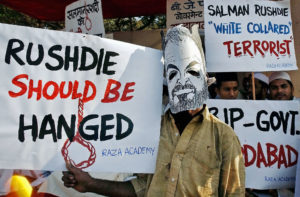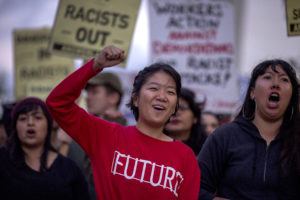Last summer, Sir Salman Rushdie told a German magazine that some normality was finally returning to his life. Two weeks later, he was stabbed multiple times on stage in New York. The incident was a cruel reminder that, despite all the time elapsed and normality resumed, the fatwa against him was every bit as valid as the day it was announced: Valentine’s Day, 1989.
It seems almost certain that more blood will be spilled in the West over blasphemy. Meanwhile, with each new “affair”, the noose around expression is tightened, and people take greater pains to err on the right side of the assassin’s veto. This means that, in effect, well-meaning people and institutions come to accept the logic of the fatwa, but the more we accept it, the lower the bar for extremist allegations drops and, perversely, the more likely violence becomes.
As a new blasphemy controversy bubbles away in Sweden, I wanted to isolate and examine the particular strand of Islamist violence aimed at those perceived to have blasphemed. For the Counter Extremism Project, I identified 71 successful attacks, plots and threat campaigns against individuals or institutions believed to have insulted Islam or the Prophet. (It’s likely there are more.) There are distinct phases to the violence, starting with the years-long global campaign of assassinations and bombings connected to The Satanic Verses. Like a pharaonic curse, catastrophe strikes those connected to the book one by one: bookshops are bombed in London, California and New York; an imam is assassinated in Brussels; a man blows himself up preparing a bomb in a Paddington hotel.
The recurring theme of this first wave of violence is the complete abyss of information. Few suspects are ever charged and, despite the ferocity of the incidents, this suggests there is a professionalism to the attacks, rather than mere anger and opportunism. The CIA was under few illusions about who was behind it, in 1992 reporting that “Iran has shifted from attacking organisations affiliated with the novel — publishing houses and bookstores — to individuals involved in its publication, as called for in the original fatwa”.
In 1991, the novel’s Italian translator was stabbed multiple times but survived, while the Japanese translator was not so lucky: Hitoshi Igarashi was killed in a stabbing frenzy outside his office at Tsukuba university. In 1993, Rushdie’s Norwegian publisher and defender, William Nygaard, was shot and left for dead, requiring months in hospital. The single worst act of violence unfolded that same year, in Turkey, where a secularist activist who translated excerpts of the novel was targeted by a riled-up mob, which set the Madimak hotel ablaze. Their target, Aziz Nesin, escaped the inferno, but 37 innocents did not.
Later, in the early 2000s, Europe’s emerging jihadist movement took up the mantle of the defence of Islam and the Prophet. The first warning signs were the targeting of San Petronio Basilica in Bologna, home to a 15th-century depiction of Muhammad. In Amsterdam, in 2004, one of Europe’s very first dealings with domestic jihadist terror was also the continent’s first exposure to jihadist blasphemy violence: the murder of Theo van Gogh. With Ayaan Hirsi Ali, he had created a film that portrayed verses from the Quran on the naked bodies of women. For this, he was stabbed, shot and nearly decapitated in broad daylight by a 24-year-old named Mohammed Bouyeri, who afterwards plunged a letter saturated with religious fury into his victim’s chest.
Bouyeri was part of a Dutch network of Salafi jihadists, which, according to his contemporary Jason Walters, was gripped by internal division over whether to focus on proselytising at home, travelling to fight American occupiers in Iraq, or launching attacks in Europe. Bouyeri unilaterally ended the debate with van Gogh’s assassination, after which authorities broke up the network. Walters tells me that even among those who opposed attacks, the murder of van Gogh was deemed legitimate (if strategically disastrous): the filmmaker had insulted Islam.
The following year, Danish newspaper Jyllands-Posten published 12 cartoons of the Prophet Muhammad in an experimental commentary on freedom of speech relating to Islam. Global unrest ensued, claiming some 200 lives. Closer to home, the impact of the cartoons affair cannot be overstated. As the data shows, plots and attacks targeting Jyllands-Posten or individual cartoonists in Denmark lasted almost a decade, until civil war in Syria grabbed the attention of Europe’s Islamists and jihadists. In fact, during the mid-2000s to 2010s, Denmark, with just six million inhabitants, was targeted more often than the United States, the traditional enemy of al-Qaeda. Denmark and Sweden were also disproportionately affected by departures for Islamic State, years later — a fact that dismantles the myth that Scandinavian countries do not suffer homegrown jihadist radicalisation due to their egalitarianism and lack of either colonial history or adventurist foreign policy.
Some of these plots were directed from overseas, such as the 2009 plans by Pakistani-American 40-something David Headley. Headley, who previously helped orchestrate the 2008 Mumbai massacre, wanted to take hostages inside Jyllands-Posten and throw severed heads from the windows to the street below. But plenty of plots were homegrown: domestic jihadists deemed the “covenants of security” with their host nations were null and void, because the cartoons constituted acts of war against Islam.
This interpretation of blasphemy is recurrent: addressing the Danish cartoons, Osama bin Laden declared that the West’s killing of Muslim women and children paled in comparison to Jyllands-Posten’s crimes: “This is the more serious tragedy,” he said in an audio message, “and the reckoning will be more severe.” Likewise, the first issue of al-Qaeda’s English language magazine made clear that killing one of the cartoonists would be an even “greater cause than fighting for Palestine, Afghanistan or Iraq”.
Similarly exaggerated equivalences have reappeared in later affairs. The man who led the campaign of accusations against Samuel Paty, the teacher who was beheaded after showing cartoons of the Prophet Muhammad during a class on free speech, warned that “tolerating” Paty’s actions could lead to a Srebrenica for French Muslims. Indeed, even a UK-registered charity mentioned the genocide of Rohingya Muslims and a Batley schoolteacher showing a Charlie Hebdo cartoon, in the same breath.
Delving into the nature of the plots is revealing. As much as jihadist violence is associated with mass casualty attacks, discriminate violence targeted at blasphemers or other perceived enemies of Islam account for a large share of total terror plots, prior to Isis. When those targets are identified, the violence is excessive and notably vicious, even by jihadist standards. Theo van Gogh was, to use the words of Ian Buruma, “slaughtered like a sacrificial animal”, for instance.
In these attacks, the violence goes well beyond the infliction of death, which can just as well be achieved by a single bullet. It is designed to humiliate, degrade and punish transgressors through extreme violence and dismemberment. For all the apparent “tradecraft”, the same characteristics can be observed among Iranian assassins in the early Satanic Verses campaign. In Britain, the pitiless stomping to death of a former imam in Rochdale accused of black magic, and the knifing of a Glaswegian shopkeeper by a follower of Pakistan’s spiralling anti-blasphemy movements, are results of the same frenzied violence.
It is this increasingly animated blasphemy fervour, emanating from Pakistan, that Britain cannot afford to ignore, given that Iranian operations and jihadist plots continue on British soil. It is the underlying force behind the controversies involving the Batley schoolteacher; last summer’s protests outside Cineworld screenings of The Lady of Heaven, a British-made epic that became the first film to show the “face” of the Prophet Muhammad; and the more recent “Quran-scuffing” incident in a Wakefield school.
In fact, clashes like these, as well as highly discriminate violence, may come to characterise the post-Isis era. Compared with the model of violence unleashed at Manchester Arena and the Bataclan, violence against “blasphemers” inspires a much wider constituency of sympathisers, apologists and relativists — precisely the oxygen terrorism needs to survive. This apologia has, at times, even extended well into the Western media. Terrorists learn, and they will not have overlooked the massive global controversy which followed the killing of Paty. In short, blasphemy violence is not only righteous and obligatory, it better serves the interests of the various extremists competing and jostling as defenders of Islam.
Admittedly, the story of blasphemy violence is not limited to attacks, which are merely the most visible and visceral part of the equation. Nor is the story of blasphemy violence simply one of intentionally vulgar and offensive cartoons, the loss of which from the public square few commentators will mourn. The Jewel of Medina was a historical novel, which lost its publisher. The Lady of Heaven was a film made by Muslims for Muslims, yet was pulled from British cinemas. The professor who lost her job was teaching a masterpiece of Persian art.
And these are just the cases we know of. Every book never written, every painting never painted, every critique never voiced and every historical inquiry never made: that is the true story of blasphemy violence.
Disclaimer
Some of the posts we share are controversial and we do not necessarily agree with them in the whole extend. Sometimes we agree with the content or part of it but we do not agree with the narration or language. Nevertheless we find them somehow interesting, valuable and/or informative or we share them, because we strongly believe in freedom of speech, free press and journalism. We strongly encourage you to have a critical approach to all the content, do your own research and analysis to build your own opinion.
We would be glad to have your feedback.
Source: UnHerd Read the original article here: https://unherd.com/




